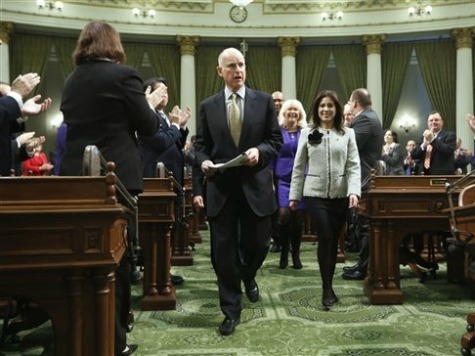Edmund G. (Jerry) Brown, Jr. is the embodiment of today’s California–a whimsical figure entwined in the California legend.
Governor Brown’s great grandfather emigrated to the U.S. from Germany–took a brief respite back East–and then in 1852 covered-wagoned it to Colusa County California where Jerry Brown’s grandmother was born in 1878.
California’s population circa 1850 was 93 thousand. The family (including Jerry’s 27%) still owns the family’s original tract of 2,700 acres. Being a three-term governor looking at a possible fourth term, with, as precedence, a two-term governor father and a near-governor sister, California politics runs in his blood.
His juxtapositions, bipolar conflicts and logical inconsistencies all coexist within this singularly impressive man. He appointed Rose Bird as Chief Justice of California, nominated Jane Fonda to the California Arts Council and sponsored the most pro-union state employee legislation in America. Most recently, he successfully sponsored and aggressively campaigned for a huge increase in California’s highly progressive income tax.
And yet, in 1992, presidential candidate Jerry Brown received the second most number of delegates in the Democratic primary (against Bill Clinton). He ran on a long-held theme of honesty in office (in contrast to Whitewater), personal morality (in contrast to Clinton’s infidelity with Gennifer Flowers et al.) and, most of all, a 13% low rate, broad-based flat tax to replace all federal taxes. He was the first serious candidate since 1913 to run for the office of President on the platform of eliminating the progressive personal and corporate income tax.
His anti-tax tilt first appeared in 1978 when Jerry Brown was Proposition 13’s secret best friend. Proposition 13 cut property tax rates by almost 60% and required a two-thirds majority for any future tax increase of any kind. Prior to the June 8th election, Governor Brown discovered and made public the existence of a surplus fund of some $5 billion which allayed the electorate’s fears of a general government shutdown. The state government Governor Brown headed created a near panic among homeowners by sending out notices of huge increases in property taxes prior to the election. Without him, Prop 13 never could have won the election by a 2-to-1 margin.
Governor Brown implemented Proposition 13 incredibly well, subvening some $5 billion of state funds to cities, counties and local districts to offset any loss in property taxes. In appreciation of Governor Brown’s good work, Howard Jarvis appeared in TV ads supporting Jerry’s reelection in 1978. Jerry Brown quite astutely morphed into Prop 13’s biggest supporter. Governor Brown was reelected in a landslide.
Under his leadership, California also abolished the state’s death tax, indexed the state’s income tax and passed the Gann spending limit. California boomed as never before, attesting to Jerry Brown’s adroitness. The economic success of California following Governor Brown’s pro-growth low tax policies would be a source of pride for him for years to come.
As Mayor of Oakland, Jerry Brown’s conservative inclinations continued to prosper. He was tough on crime, fiscally disciplined and sponsored two charter schools, a military academy for the city’s wayward youth and a school for pursuit of the arts. And to top it off, he invited the U.S. Marine Corps to use Oakland harbor land for military exercises. They accepted.
As of April 1st, 2014, California is noteworthy because it has:
- the fourth highest state and local tax burden in the country,
- the third highest educational employee pay in the nation with the fourth lowest student test scores in the nation (according to Laffer Associates analysis of U.S. Department of Education NAEP test scores),
- the most restrictive regulatory burden,
- the highest state-only sales tax rate,
- the most progressive personal income tax schedule,
- the highest state personal income and capital gains tax rate, and
- the California’s teachers union has been the single largest contributor to political campaigns in California over the past decade ($212 million)–double that of the next largest contributor, also a state government employees union.
And, as a consequence of these policies, California has:
- the seventh highest share of public employee unionization,
- the fourth highest unemployment rate in the nation,
- the fourth worst highways in the country,
- the third highest workers compensation costs,
- the highest poverty rate in the nation,
- the highest paid public employees, and
- the greatest net outflow of state adjusted gross income.
The issues are clear and the correct answers are obvious: we’re all waiting on Jerry.
Dr. Laffer has had a long association with Governor Brown. Dr. Laffer was involved in California’s Proposition 13. After the passage of Proposition 13 he spent three days with the Governor and his cabinet (including Director of Finance Dick Silberman and Chief of Staff Gray Davis) planning the future of California with Prop. 13. Dr. Laffer also wrote candidate Brown’s tax plan for the 1992 Democratic Presidential primary. He has kept in contact with Jerry Brown over the years. Dr. Laffer is the author of Eureka! How to Fix California.

COMMENTS
Please let us know if you're having issues with commenting.